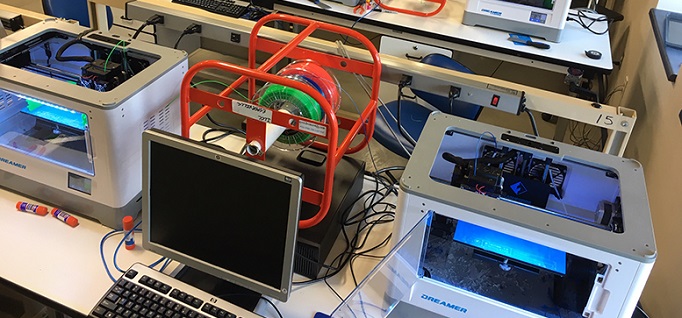Making the best of the situation
By Madeline Patton
December 16, 2020
How community colleges have leveraged the pandemic to bring awareness to technician education programs
While Covid sidelined most MentorLinks activities planned for 2020, two faculty-led teams actually leveraged pandemic-related public health precautions to make progress toward their long-term goals to raise awareness of their colleges’ technician education programs.
The American Association of Community Colleges offers the MentorLinks: Advancing Technological Education program with support from the National Science Foundation. To help colleges develop or strengthen technician education programs in science, technology, engineering and math fields, MentorLinks provides mentoring from community college subject matter experts, professional development opportunities and technical assistance for two years.
Small tweak, big difference
Early in the year, Iowa Lakes Community College (Iowa) was off to a strong start in its effort to publicize the multiple career paths — in wind energy, environmental studies, HVAC — available through its engineering technology program. Student demonstrations of various technologies at high school recruitment events had gone well, and leaders of a regional education consortium responded enthusiastically to partnership ideas that Chad Tischer shared during an early March meeting. Tischer is coordinator of the engineering technology program at Iowa Lakes and director of Advancing Integrated STEM Education for 21st Century Workforce, the college’s MentorLinks project.
While teaching remotely in mid-March, Tischer received a query about whether the college’s four 3D printers could be used for a community effort to make personal protective equipment (PPE). Soon he and Mike Gengler, coordinator of the college’s wind energy program, were back on campus to direct the 3D printers’ production of headbands for a local manufacturer who repurposed his equipment to make acrylic face shields. When healthcare providers reported that the masks’ bands were irritating their ears, Tischer and Gengler programmed one of the machines to make “ear savers” for the masks to make them more comfortable.
“I see it as good public relations. When people from the community get a hold of the college and have a question or need something, I love that because it means we are part of the community,” Tischer said.
He enlisted students in devising ways to improve the open-source software for the 3D printer, but students could not participate directly in the manufacturing because the campus was closed. From a distance, they seemed to appreciate that equipment they consider “fun” was helping the region deal with PPE shortages.
Over the course of several months, 700 headbands for face shields were created for local healthcare providers, and 1,800 ear savers were donated throughout the community and distributed in back-to-school bags for faculty.
Spreading the word
Newspaper and radio reports about the college’s PPE effort prompted a call from a local manufacturer who said he was unaware of the college’s engineering technology program. At his request, Tischer and Gengler used the 3D printers to make clips to hold acrylic face shields on the baseball caps that the manufacturer’s employees wear to protect from Covid transmission.
“What we’re trying to do with MentorLinks is get the word out that we offer these programs that have good-paying jobs with a two-year degree. And, actually, so this little PPE project that we ended up doing was really good for that,” he said.
Building stronger credibility
One of the key things that Vicki Badgley learned during the 2019 MentorLinks meeting in Washington, D.C., was that she could take the Certified Information Systems Security Profession (CISSP) exam. Badgley is a professor and director of computer information technology (CIT) at South Arkansas Community College (Arkansas).
Her mentor, Elizabeth Hawthorne, who was a professor of computer science and cybersecurity at Union County College (New Jersey) for 25 years, explained that certification is not just for people working in the industry. Hawthorne encouraged Badgley to obtain the credential because employers value it as an indicator of high-quality cybersecurity program management. Raising the program’s profile with employers and prospective students is one of Badgley’s MentorLinks goals.
So Badgley began studying for the rigorous exam during the holiday break last year. In the spring, she blocked off hours in her schedule to study even while converting her in-person courses for remote delivery.
“Oh, you just think, ‘I have 26 hours in a day,’” she said when asked how she persevered amid Covid challenges. Public health restrictions meant she was at home most weekends, so studying for long stretches was a bit easier than it would have been normally, she said. A state grant covered the cost of the online preparation course she took.
Badgley said studying intensely clarified cybersecurity concepts that she teaches and passing all eight sections of the exam “validates what I know.”
To further boost the credibility of the college’s computer information technology program, Badgley also took the CompTIA Security+ exam with its hands-on skills focus and passed it.
To help bring attention to the quality of the college’s programs, Badgley’s email signature now includes the abbreviations for both industry certifications.
This article originally appeared in CC Daily.



